Data on births, deaths and marriages presented in this release were obtained from the Certificate of Live Birth (Municipal Form 102), Certificate of Death (Municipal Form 103) and Certificate of Marriage (Municipal Form No. 97) that were registered at the Office of the City/Municipal Civil Registrars and forwarded to the Philippine Statistics Authority - Provincial Statistical Offices in Ilocos Region. Information included births, deaths and marriages registered in April to June 2018 and April to June 2019.
Birth Statistics
The number of registered live births in Ilocos Region during the second quarter of 2019 summed up to 23,018, a slight increase of 1.5 percent compared to 22,668 births on the same period of 2018. The daily average birth occurrence during the second quarter of 2019 was computed at 253 births or an average of 10 babies born per hour. The month of May 2019 was observed to have the highest average daily births at 272 babies. While in second quarter of 2018, the month of April registered the highest daily average birth with 254 babies.
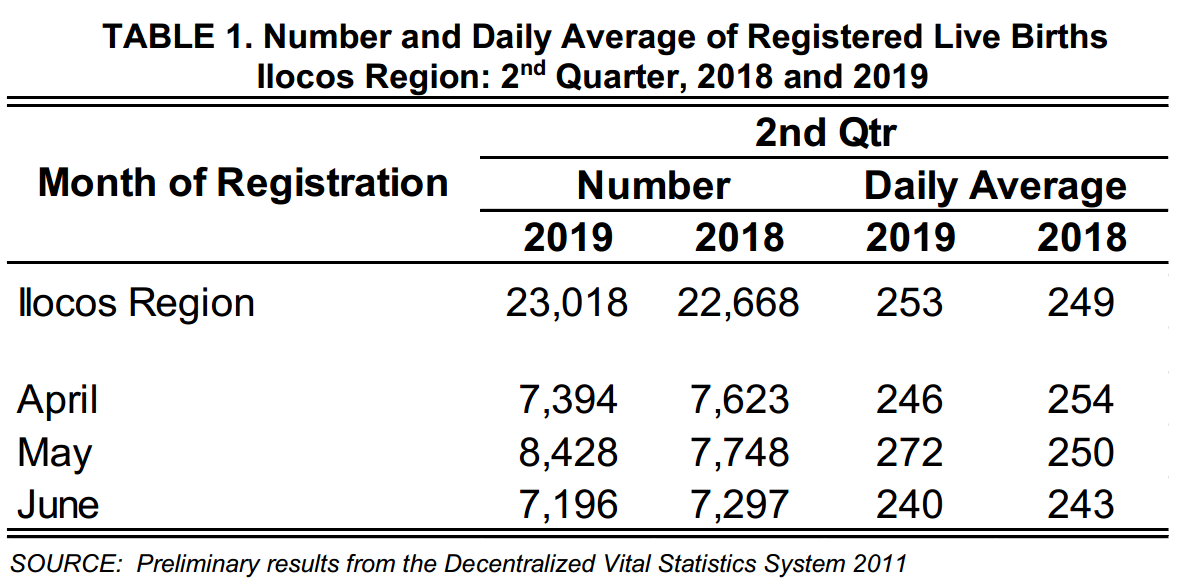
The highest number of registered live births during the second quarter of 2018 and 2019 was recorded in the month of May. The percent share of the total births in May to the quarterly totals were 34.2 percent in 2018 and 36.6 percent in 2019.
The month of June was observed to have the least number of registered live births in the second quarter of 2018 and 2019. The total registered live births in June 2018 and 2019 were 7,297 and 7,196 births, respectively.
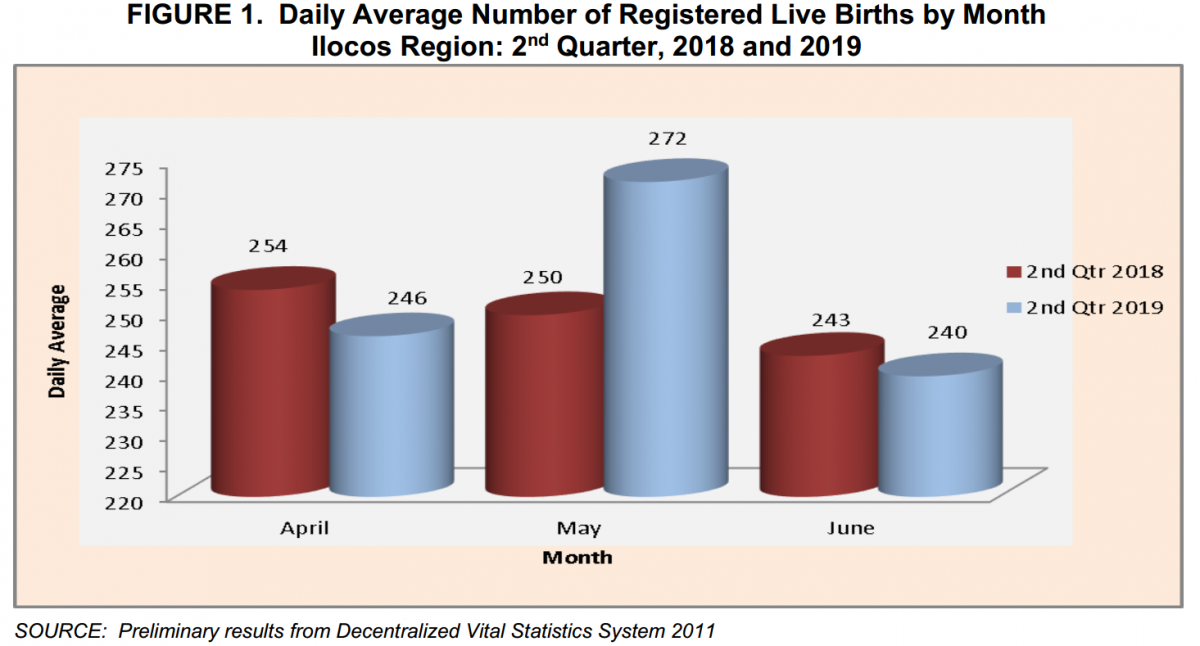
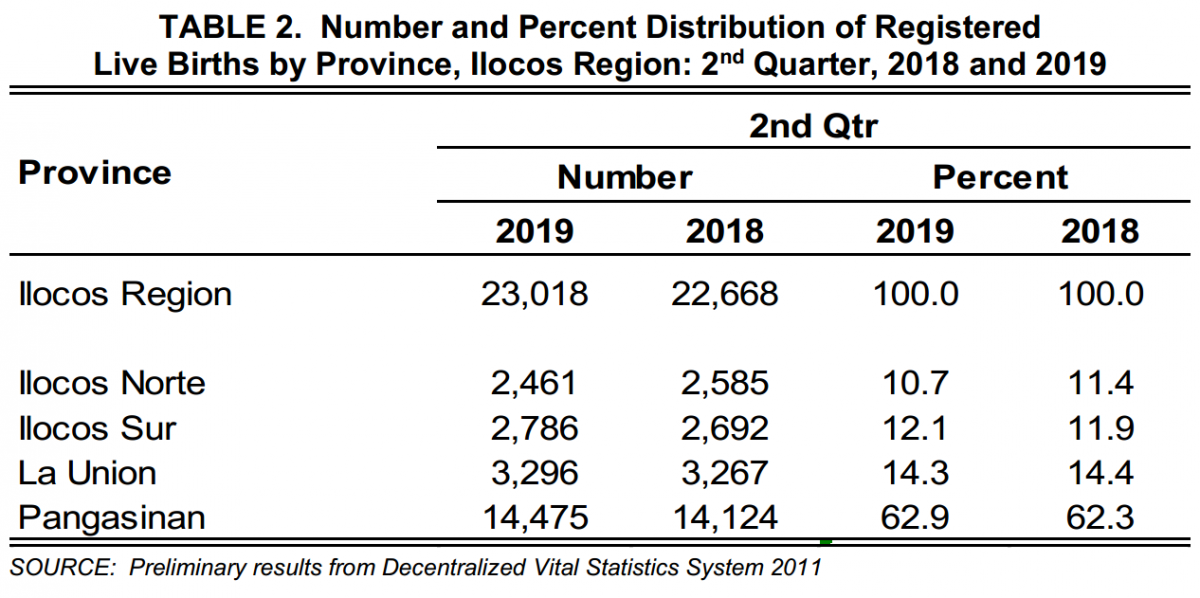
Among the provinces in the region, the province of Pangasinan registered the highest number of births in the second quarter of 2019. Its share was more than half (62.9 percent share) of the total registered births in Ilocos Region. The province of La Union ranked second with 3,296 births (14.3 percent share), followed by the province of Ilocos Sur with 2,786 births (12.1 percent share) and the province of Ilocos Norte with 2,461 (10.7 percent share).
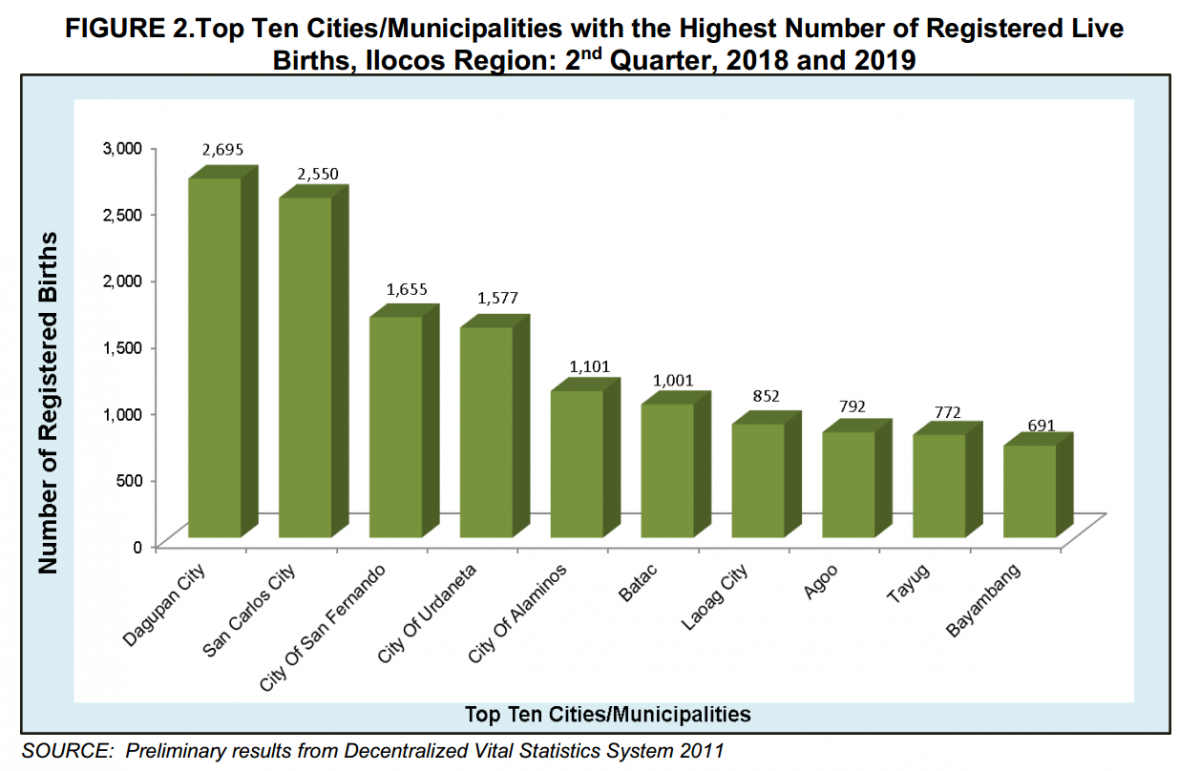
In second quarter of 2019, Dagupan City, Pangasinan ranked first among the top ten Cities/Municipalities that registered the highest number of live births with 2,695. This was followed by San Carlos City,Pangasinan with 2,550 births;City of San Fernando, La Union with 1,655 births; City of Urdaneta, Pangasinan with 1,577 births; City of Alaminos, Pangasinan with 1,101 births; and Batac, Ilocos Norte with 1,001 births.
On the other hand, the Municipalities of Dumalneg, Ilocos Norte, Gregorio Del Pilar and Sigay, Ilocos Sur had the lowest number of registered live births in second quarter of 2019 with one registered birth each. It was followed by Burgos, La Union with two registered live births, Lidlidda, Ilocos Sur with three registered live births, Adams, Ilocos Norte, San Esteban and San Vicente, Ilocos Sur with four registered live births each and Burgos, Ilocos Norte and Laoac, Pangasinan with six registered births each.
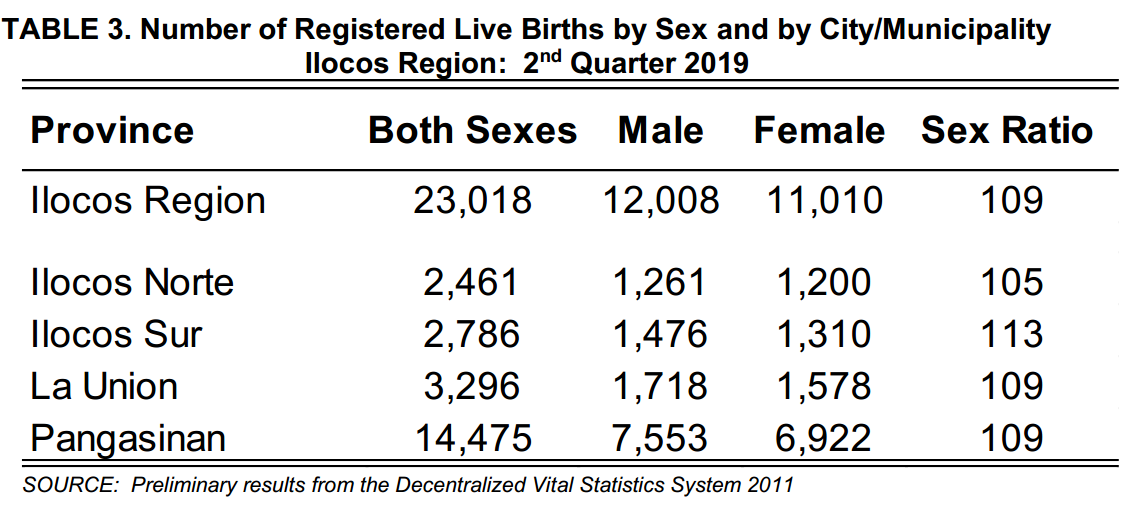
Males (12,008) outnumbered females (11,010) in terms of registered live births during the second quarter of 2019, resulting to a sex ratio of 109 males per 100 females.
The province of Ilocos Sur posted a sex ratio that is higher than the regional ratio. The highest sex ratio of 1,476 males per 1,310 females was recorded in Ilocos Sur. This was followed by La Union and Pangasinan with same sex ratio of 109. On the other hand, the lowest sex ratio of 1,261 males per 1,200 females was recorded in the province of Ilocos Norte.
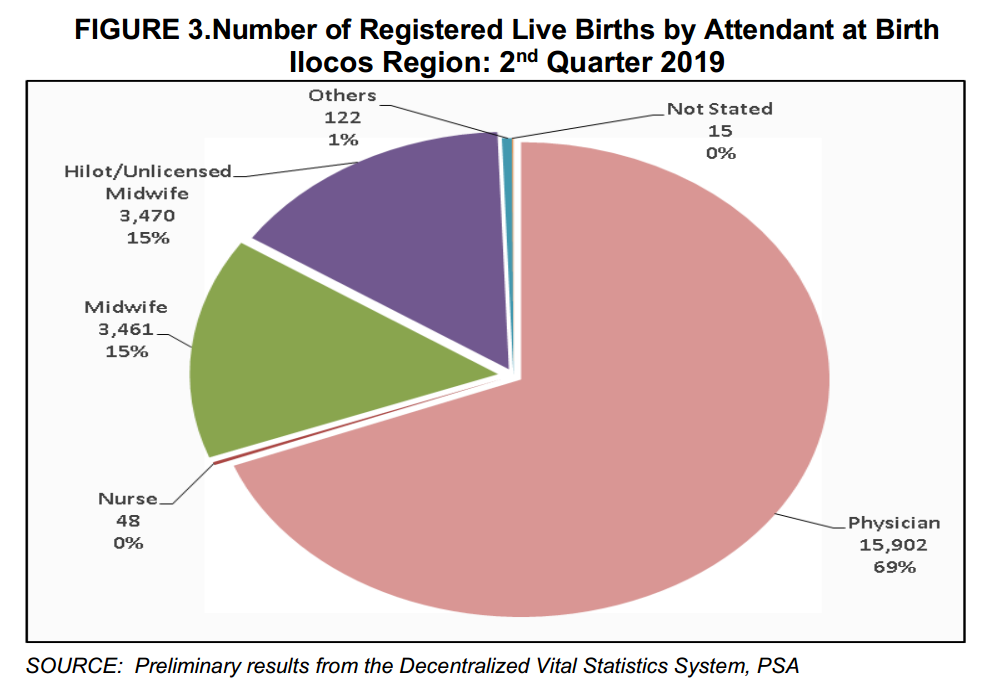
In second quarter of 2019, 84.3 percent or 19,411 of total registered live births were attended by medical practitioners which may either be a physician, a nurse or a midwife. The province of La Union had the highest percentage of birth deliveries tended by health professionals with 88.1 percent of the total registered live births in the province followed by Pangasinan with 85.1 percent, Ilocos Sur with 80.3 percent and Ilocos Norte with 79.2 percent.
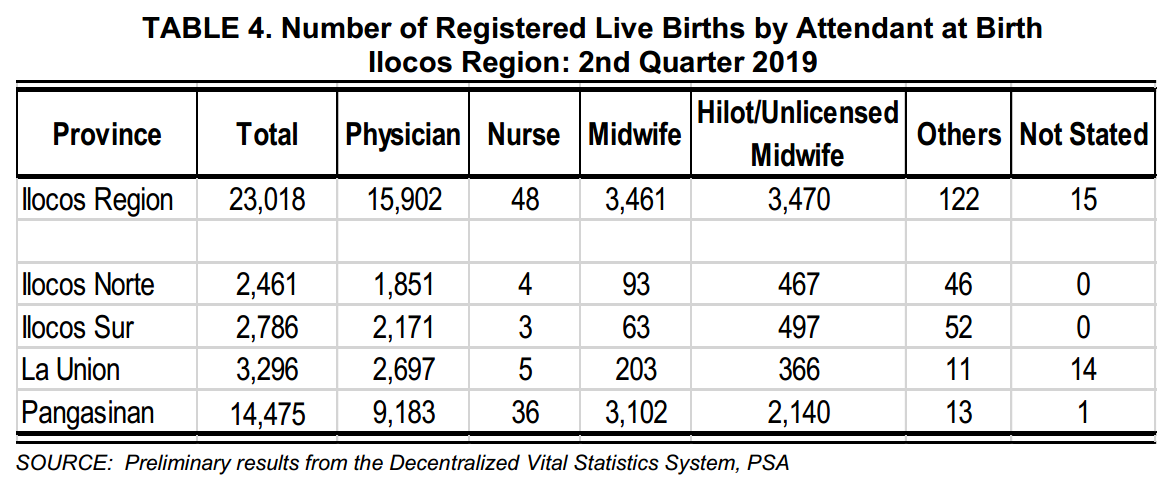
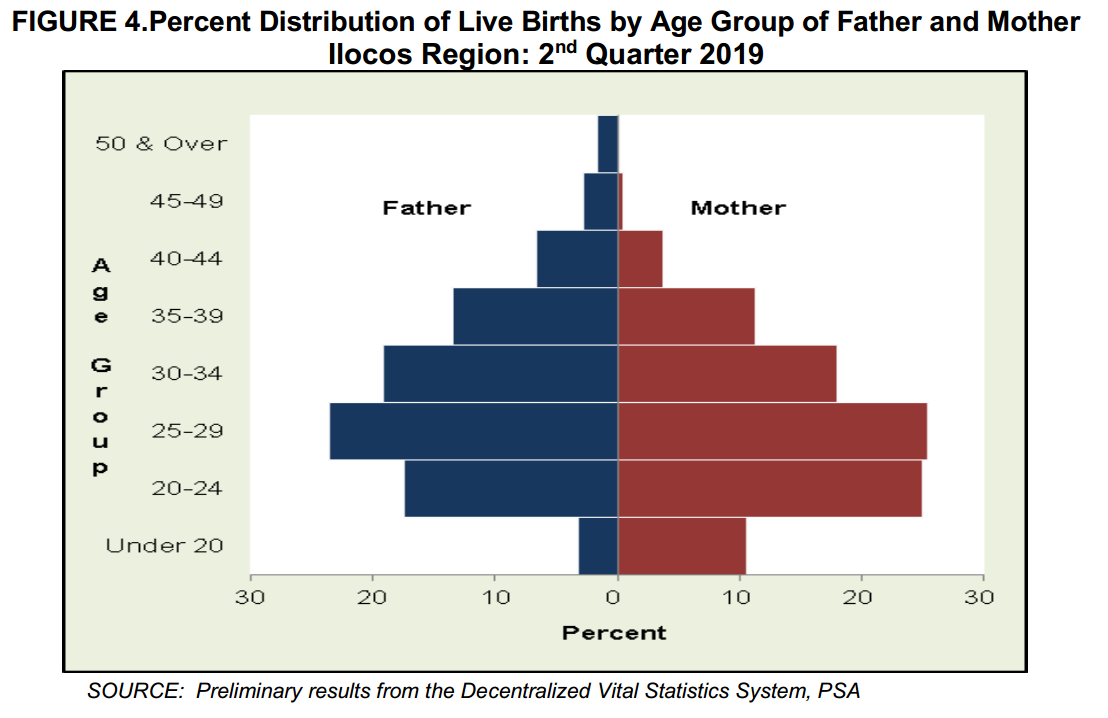
More than a quarter (25.3 percent) or 5,830 of mothers who gave birth in second quarter of 2019 belonged to age group 25 to 29. Meanwhile, the highest proportion of fathers belonged to age group 25 to 29, with 23.6 percent of the total number of fathers of babies with registered births in second quarter of 2019.
Furthermore, it can also be noted that teenage mothers (2,424) was more than thrice than that of teenage fathers (752).

Meanwhile, a total of 18 mothers at age group 50 and over gave birth to babies who were registered in second quarter of 2019. The number of fathers belonging to age group 50 and over (365), however, was 20 times more than that of mothers.
The median age for mothers was 27.9 years old while for fathers, 31.5 years old.
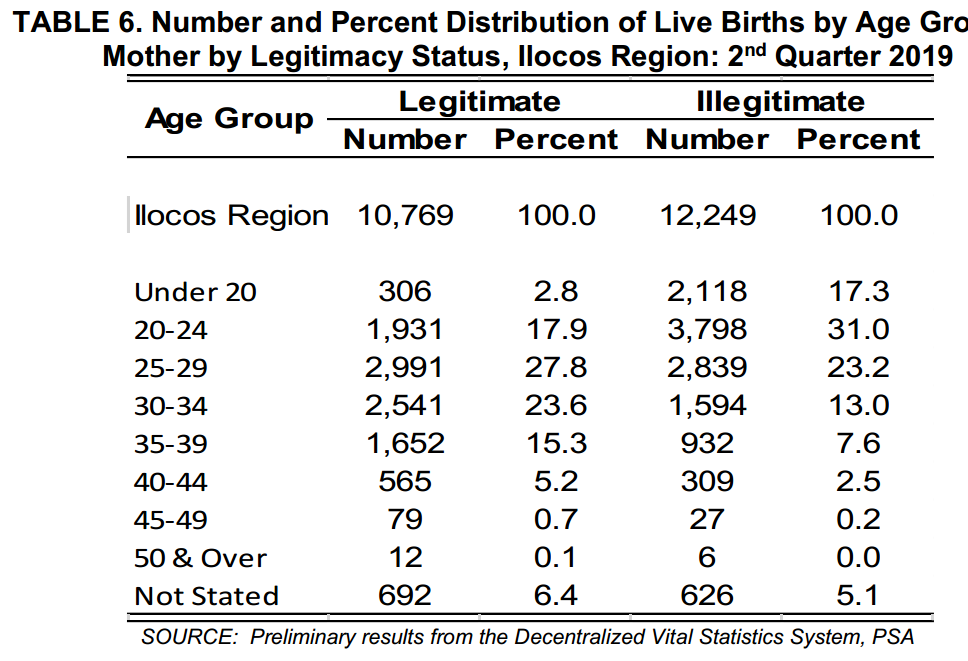
More than half (53.2 percent) or 12,249 of the total registered live births in second quarter of 2019 were born illegitimate. Mothers at the age group 20-24 recorded the highest number of born illegitimate with 3, 798 birth or 31.0 percent. It was followed by age group 25-29 with 2,839 births and age group under 20 with 2,118 births.
Marriage Statistics
There were 8,740 marriages registered during the second quarter of 2019, showing a decrease of 2.1 percent from the figure on the same period last year of 8,932 marriages.
Two provinces recorded an increase in the number of registered marriages from second quarter of 2018 to second quarter of 2019. A bigger increase was noted in La Union from 1,464 to 1,558 marriages (6.4 percent). While that of Ilocos Norte increased from 1,019 to 1,037 marriages (1.8 percent).
On the other hand, the provinces that posted a decrease in the number of registered marriages were Ilocos Sur from 1,392 to 1,323 (5.0 percent) and Pangasinan from 5,057 to 4,822 (4.6 percent).
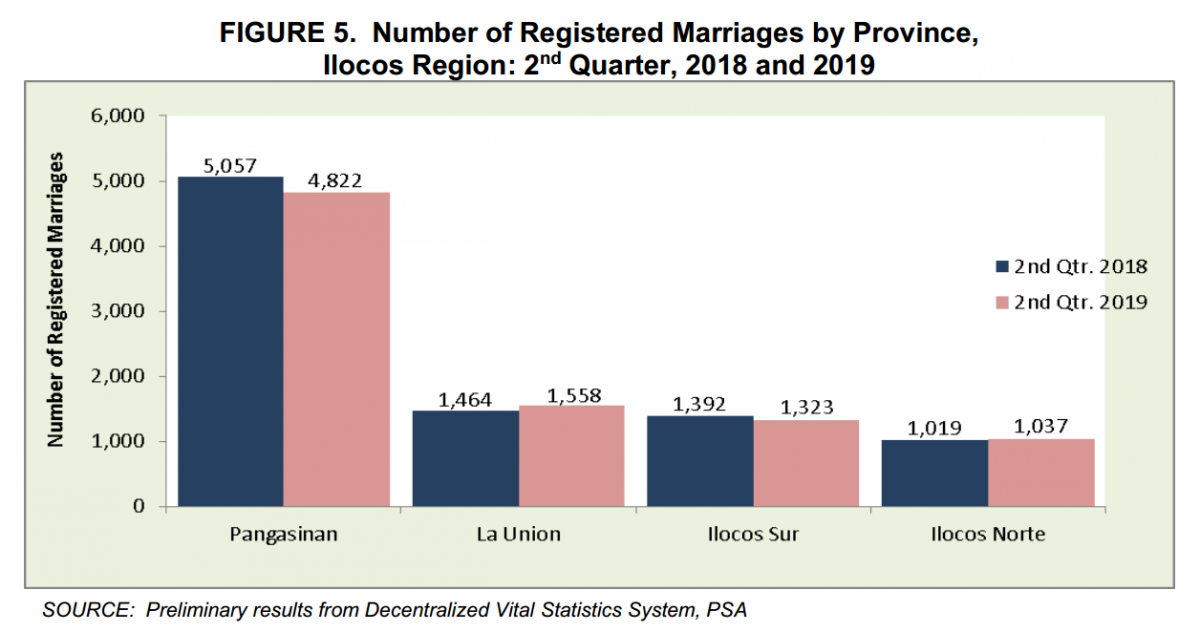
The number of registered marriages in the province of Pangasinan went down to 4,822 during the second quarter of 2019 from 5,057 in the same quarter of 2018. However, the province of Pangasinan remained with the most number of registered marriages in the region. La Union ranked second with 1,558 (17.8 percent share) followed by Ilocos Sur with 1,323 (15.1 percent share). In same period of 2018, La Union also ranked second with 1,464 marriages (16.4 percent share) while Ilocos Sur ranked third with 1,392 marriages (15.6 percent share).
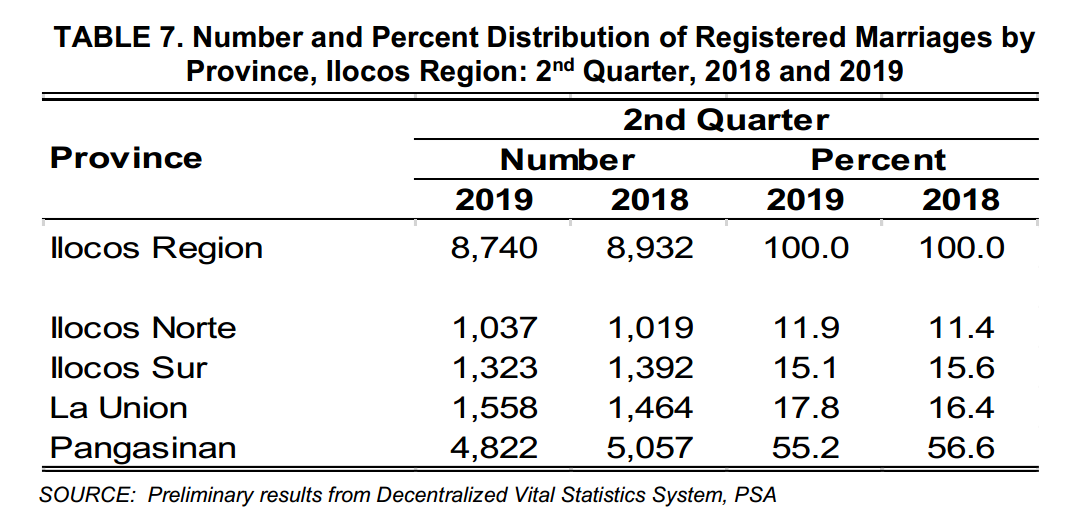
On the other end, the province of Ilocos Norte posted the least number of registered marriages during the second quarter of 2018 and 2019 with 1,019 (11.4 percent share) and 1,037 (11.9 percent share), respectively.
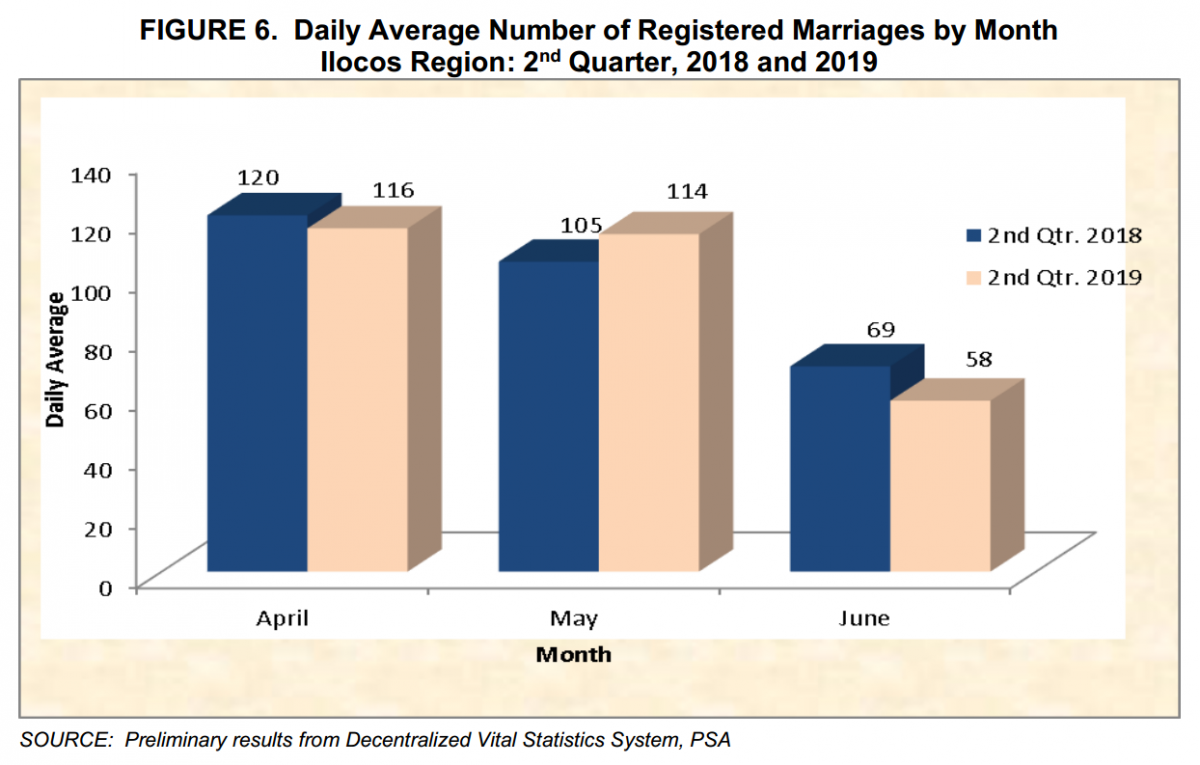
The month of May was the most preferred month to tie the knot during the second quarter of 2019 with a total of 3,532 marriages. It corresponds to a daily average of 114 registered marriages which surpassed the regional daily average number during the quarter. In the same period of last year, April was the most preferred month to tie the knot with a total of 3,609 marriages translating to a daily average of 120 registered marriages. The least number of marriage occurrences during the second quarters of 2018 and 2019 were recorded in June posting a daily average of 69 and 58 marriage occurrences, respectively.

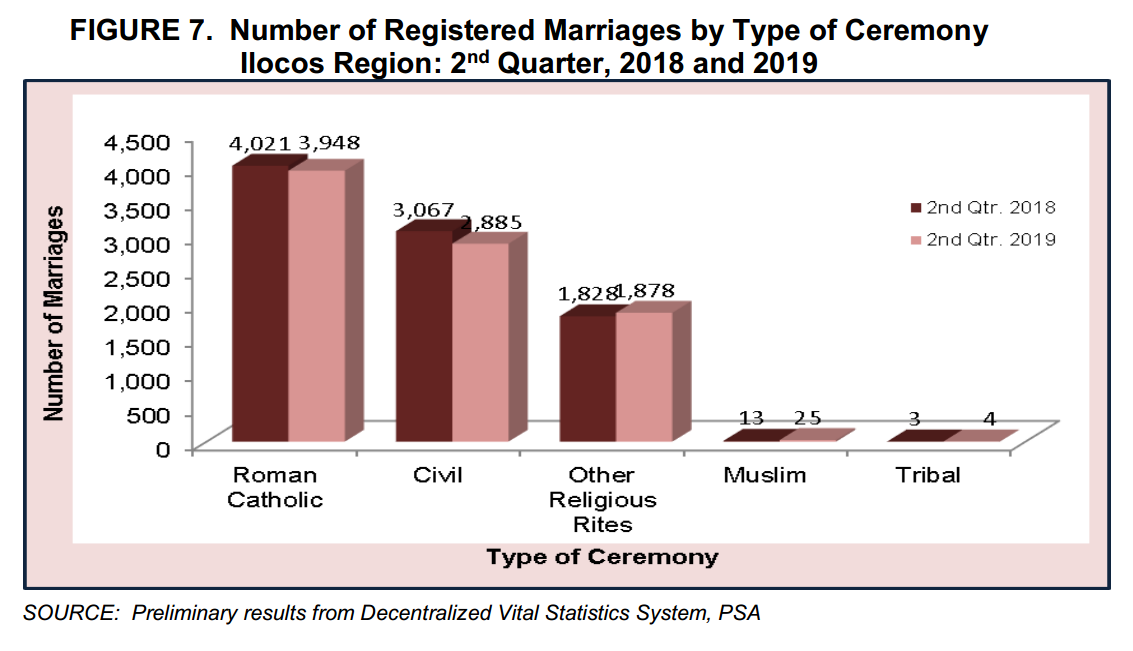

Marriages officiated in Roman Catholic Church topped the list among all types of marriage ceremonies in second quarter of 2019. It comprised 3,948 marriages or 45.2 percent of the total reported marriages. Marriages performed in civil rites ranked second with 2,885 marriages or 33.0 percent share followed by other religious rites with 1,878 or 21.5 percent.
A year earlier, marriages solemnized through Roman Catholic registered the highest number of marriages with 4,021 marriages or 45.0 percent share, followed by civil rites with 3,067 marriages or 34.3 percent share.
On the other end, marriages carried out under tribal rites posted the lowest number of registered marriages both in second quarter 2018 and second quarter 2019 with three and four marriages, respectively.
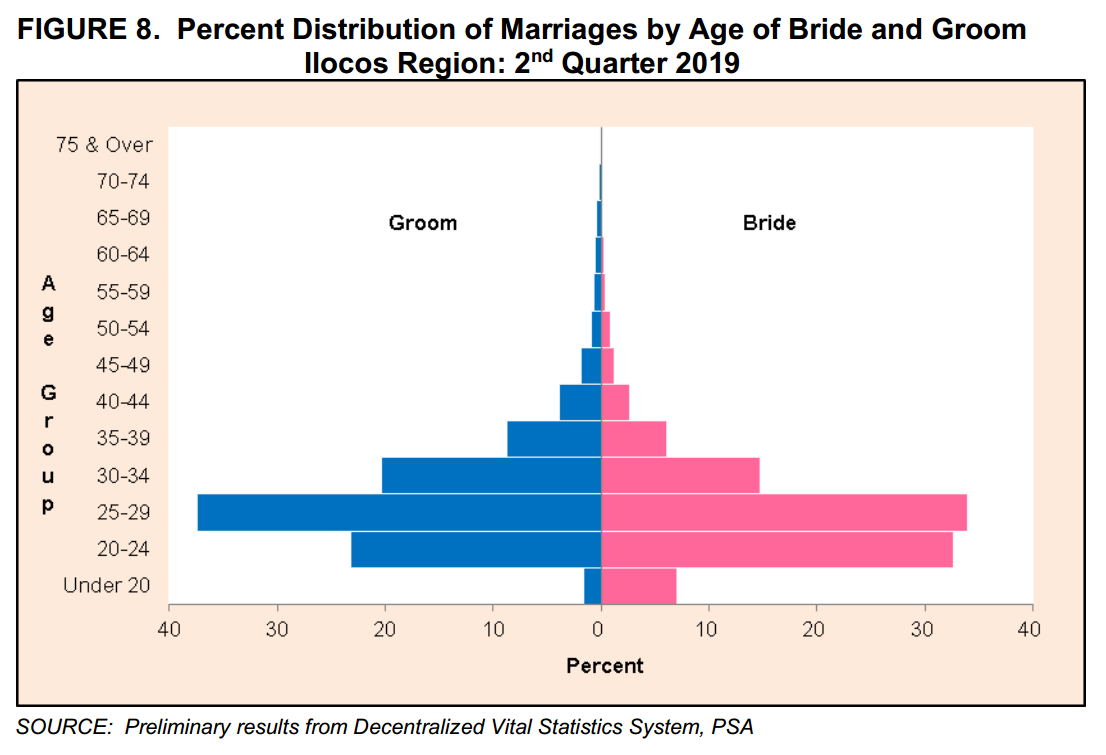
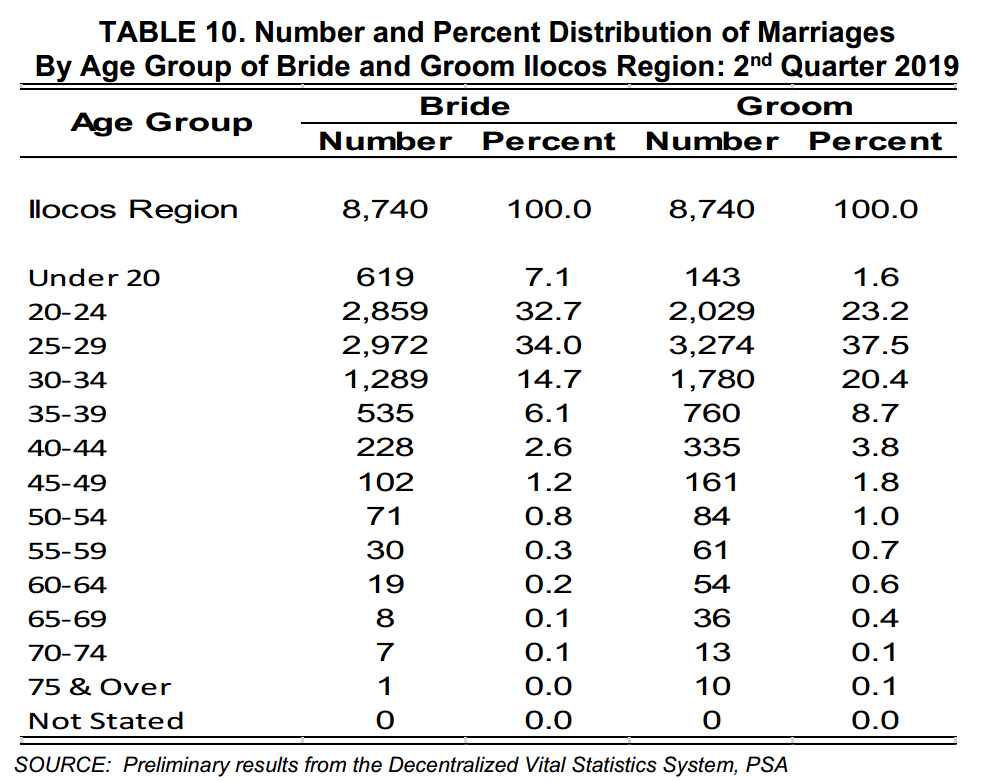
The median age at marriage for brides and grooms were 26.5 and 28.4, respectively. The largest number of brides and grooms, who got married, belonged to ages 25 to 29 in second quarter of 2019 with 2,972 or 34.0 percent and 3,274 or 37.5 percent, respectively. Moreover, the number of teenage brides (619 or 7.1 percent) was more than four times than the number of teenage grooms (143 or 1.6 percent).
On the contrary, at age 50 years old and over, the number of grooms (258 or 2.9 percent) was almost twice the number of brides (136 or 1.6 percent). It can be noted that men tend to marry even on or after their golden years. Grooms aged 75 years and over (10) were ten times more than the number of brides (1).
Death Statistics
A total of 8,970 deaths were registered during the second quarter of 2019. The figure indicated a slight decrease of 0.6 percent death occurrences from the same period of 2018 figure of 9,020.
The province of Pangasinan ranked first in terms of the number of registered deaths during the second quarter 2019, with a total of 5,144 or 57.3 percent share of the total registered deaths in the region. La Union placed second with 1,433 registered deaths (16.0 percent share), followed by Ilocos Norte with 1,214 (13.5 percent share) and Ilocos Sur with 1,179 (13.1 percent share).
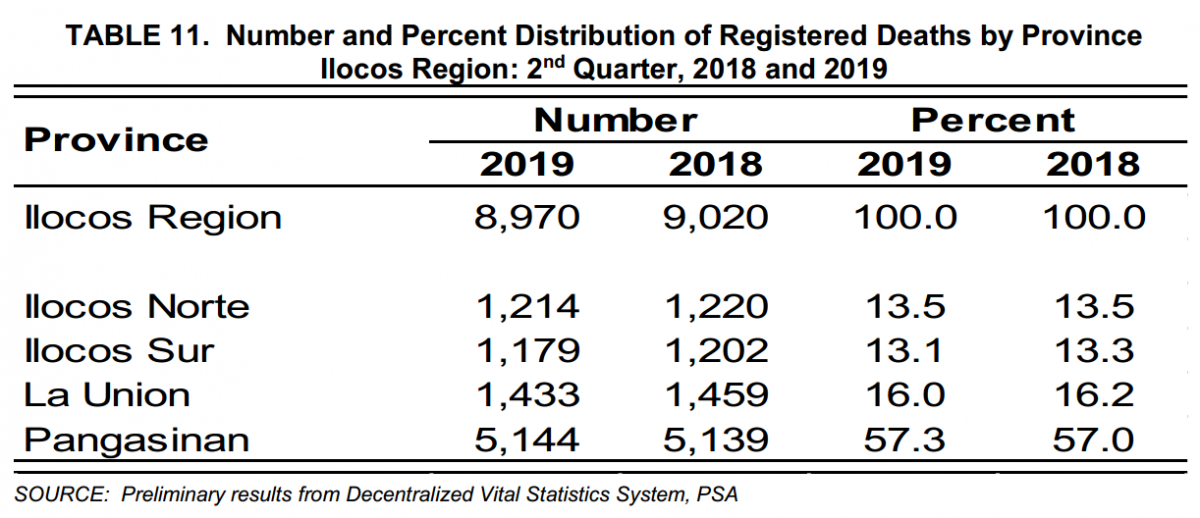
In the same quarter of 2018, Pangasinan recorded 5,139 deaths or 57.0 percent of the total registered deaths in the region. La Union registered 1,459 (16.2 percent share), Ilocos Norte with 1,220 (13.5 percent share) and Ilocos Sur with 1,202 (13.3 percent share).
Comparing the two periods, only the province of Pangasinan posted a percent increase at 0.1 percent from 5,139 deaths in 2018 to 5,144 deaths in 2019. On the other hand, Ilocos Sur reported the highest percent decrease at 1.9 percent from 1,202 deaths in second quarter of 2018 to 1,179 deaths in same period of 2019. Followed by La Union with 1.8 percent and Ilocos Norte with 0.5 percent decrease.
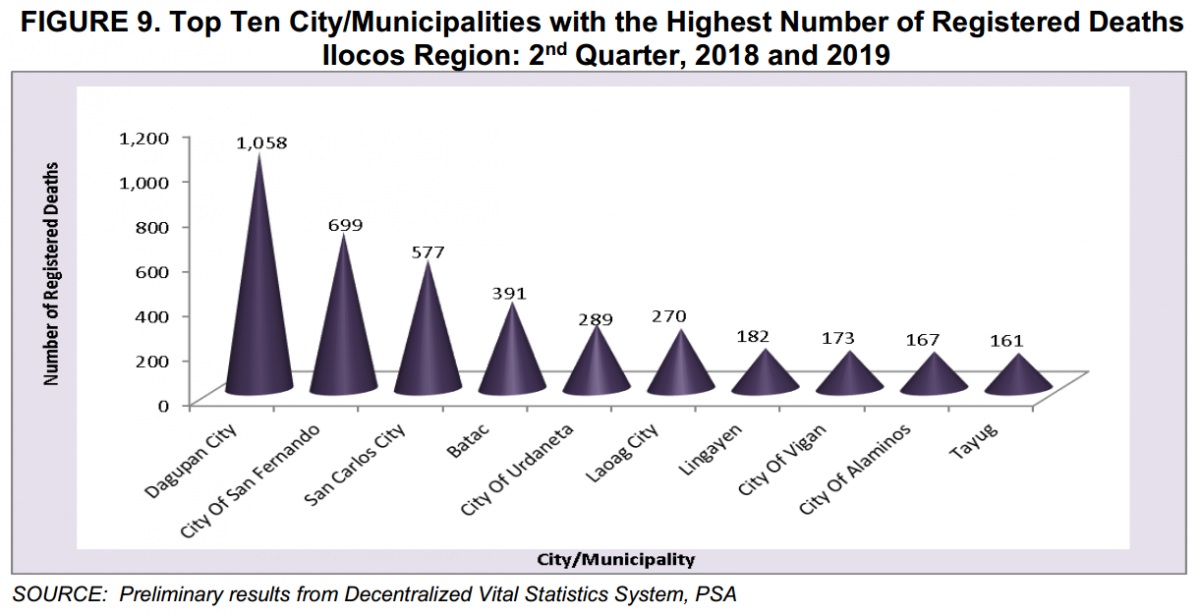
The cities of Dagupan, San Fernando, San Carlos, Batac and City of Urdaneta posted the highest number of registered deaths in the second quarter of 2019 with 1,058, 699, 577, 391 and 289 deaths, respectively. On the other hand, the municipalities of Dumalneg, Adams, Sigay, Carasi, Sugpon and Gregorio Del Pilar had the least number in terms of the number of registered deaths: Dumalneg with one registered death; Adams with two deaths; Sigay and Carasi with three deaths each; and Sugpon and Gregorio Del Pilar with four deaths each.

During the second quarter of 2019, mortality was at its peak in the month of May with total registered deaths of 3,157. This figure was more than one-third of the regional quarterly total of 8,970 death occurrences. The number of deaths in the month of May 2019 translates to an average of 102 death occurrences per day. The figure was higher than the daily average death occurrences in the region.

In same period a year ago, the highest number of registered deaths was in the month of April with 3,177 death occurrences, followed by the month of May with 3,058. The smallest number of registered deaths was in June with 2,785. April 2018 has the highest daily average of 106 death occurrences followed by May with a daily average of 99 death occurrences.
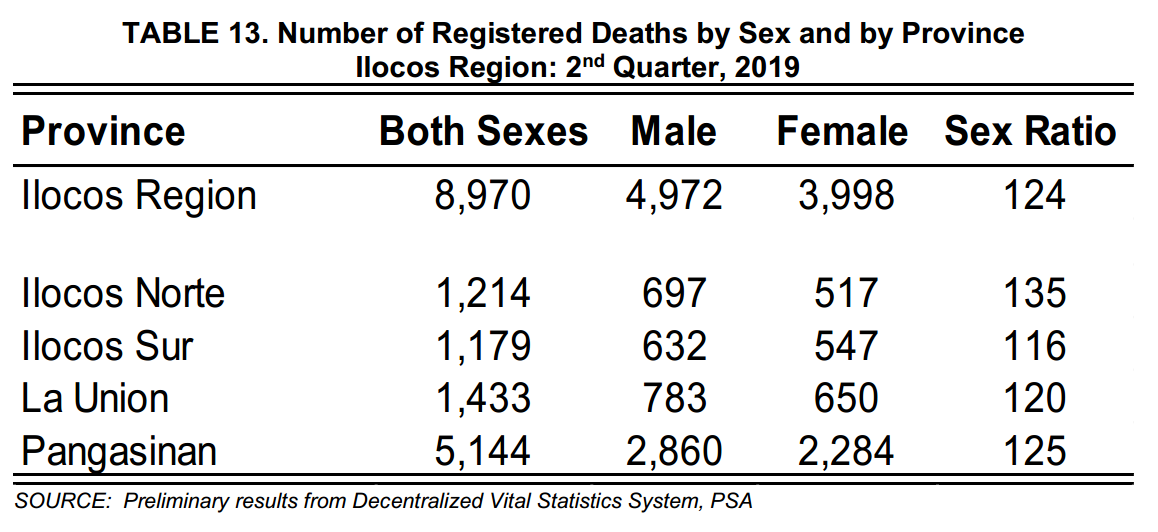
There were more death occurrences among males (4,972) than females (3,998) in Ilocos Region during the second quarter of 2019. The computed sex ratio during the quarter was 124 male deaths for every 100 female deaths.
There were two provinces that posted a sex ratio higher than the regional sex ratio. Ilocos Norte posted the highest sex ratio with 135, Pangasinan ranked second with 125 and followed by La Union with 120. The lowest computed sex ratio of 116 male deaths per 100 female deaths was noted in Ilocos Sur.
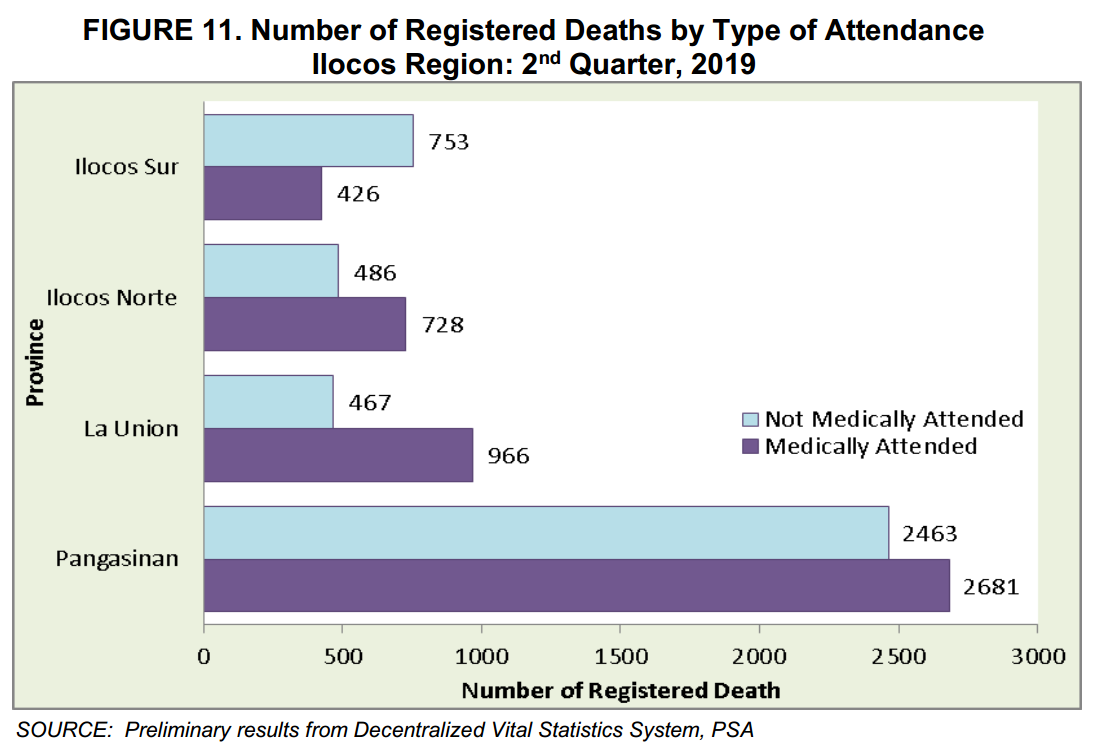
Out of the 8,970 registered deaths in second quarter of 2019, more than half (53.5 percent or 4,801 registered deaths) were attended by medical authorities. The remaining 46.5 percent or 4,169 registered deaths did not get medical attendance.
La Union recorded the highest percentage of deaths attended by medical authorities with 67.4 percent of the total registered deaths in the province followed by Ilocos Norte with 60.0 percent, Pangasinan with 52.1 percent and Ilocos Sur with 36.1 percent.
Explanatory Notes
Introduction
Vital statistics are derived from information obtained at the time when the occurrences of vital events and their characteristics are inscribed in a civil register.
Vital acts and events are the births, deaths, fetal deaths, marriages, and all such events that have something to do with an individual’s entrance and departure from life together with the changes in civil status that may occur to a person during his lifetime. Recording of these events in the civil register is known as a vital or civil registration and the resulting documents are called vital records.
The structure of vital statistics system
The production of vital statistics comprised of the system of operation in which the registration of vital events is an important component. The system begins with the registration followed by processing and controlling of vital records and ends with the compilation and analysis of vital statistics.
Under commonwealth Act 591, the Bureau of Census (now PSA) is mandated to generate general purpose statistics and to carry out administer Act No. 3753.
Under the same law, the head of the NSO (now part of PSA) is also the Civil Registrar General (CRG) who directs and supervises the local civil registration activities in the country. The CRG in this regard is empowered to issue implementing rules and regulation on civil registration for proper compliance and, to design and order the printing of the necessary forms.
The vital statistics system involves different entities and cutting across different departments and personalities.
For the registration of vital events, the Local Civil Registry Offices (LCROs), which are the registration units in the country and headed by the City/Municipal Civil Registrars (C/MCRs), are under the Local Government Units (LGUs). The hospitals, clinics, rural health units and similar institutions including barangay secretaries, practicing physicians, midwives, nurses, traditional midwives, solemnizing officers from various religious sects and denomination are required to assists in the reporting of vital events for registration at the LCROs. The concerned parents, next of kin, contracting parties, witness or the person who has full knowledge of the occurrence of the events are also required to report the event, in default of the first mentioned set of informants.
The processing and controlling of vital documents are done at the LCROs and at the PSA Provincial and Central Offices.
The compilation and analysis of vital statistics is taken cared of by PSA central offices under the Vital Statistics Division (VSD) of the Civil Registration Service Office.
The Registration Method
As mandated in Act 3753, all vital events that marked the entry and departure of a person of his lifetime and the changes in his/her civil status shall be registered. The registration method is defined as continuous, permanent and compulsory recording of the occurrences and characteristics of vital events, primarily for their value as legal documents and secondary for their usefulness as a source of statistics.
Where to register the event
As a general rule, vital events should be registered at the LCRO where the events occur. In special cases, where the document about a vital event is presented to the LCRO which is not the place of occurrence, the same maybe accepted and is considered as out-of-town reporting. However, such documents should not be registered by the receiving LCRO. It must be forwarded to the LCRO where the event took place for purpose of registration.
Definition of terms and Concepts
This section presents the significant terminologist and descriptions in the foregoing highlights and tables are defined below. Included are some items found in the certificates and summary measure used in the certificates and summary used in the describing the facts of events.
Vital statistics on the other hand, are derived from information obtained at the time when the occurrences of vital events and their characteristics are inscribed in a civil register.
Live Birth is a complete expulsion or extraction from its mother of a product of conception, irrespective of the duration of the pregnancy, which after such separation, breathes or shows any other evidence of life, such as beating of the heart, pulsation of the umbilical cord, or definite movement of the voluntary muscles, whether or not the umbilical cord has been cut or the placenta is attached: each product of such a birth is considered live born.
Marriage is a special contract of permanent union between a man and a woman entered into in accordance with law for the establishment of conjugal and family life. It is the foundation of the family, a social institution that is governed by law and not subject to stipulation.
Death is a permanent disappearance of evidence of life. A fetus with intrauterine life of seven months or more and born alive at the time it was completely delivered from the maternal womb but died later shall be considered as death and shall be registered.

